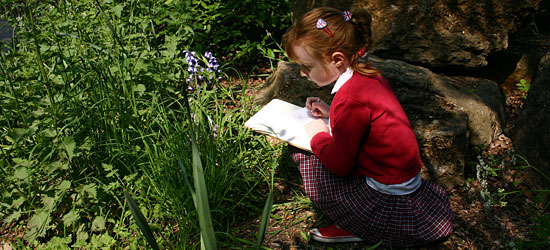Exploration of nature
Critical to child development
| June 2012All children are eager to connect with nature; given a chance, they develop a strong love for the earth and everything upon it. Their senses are wide open to the great and the small – as children watch moon and stars, they are awed to catch a glimpse of our planet’s place in the universe, while tiny creatures and objects grip their imaginations too. Perhaps the miniature size of ladybird, tadpole or acorn rouses feelings of sympathy in young children. Often a child will stop to watch an ant or examine a pebble that an adult would not even notice. Gentleness toward plants and animals can extend to understanding for fellow humans as a child develops.
Children’s affinity with living things needs to be nurtured; this can happen in rural and urban environments. Having worked with young children in wilderness areas (Catskill Mountains, USA) and in densely populated regions, I’ve observed that they involve themselves no matter what the setting, provided we give them time outdoors to engage with the rhythms of weather, the habits of an insect, or the design and scent of a flower – whether a rare specimen or the dauntless dandelion pressing through city pavements. A child can befriend a tree in a forest or an urban park. The outdoors is always there and always free.
Even the youngest children are receptive to nature’s influences. I used to park babies’ cots beneath a tree, where fresh air, birdsong, and the interplay of light and shadow lulled them to sleep. I’d bring the tub outdoors too, so they could splash freely. One baby became very quiet during his bath; following his eyes, I realised he was watching swallows swoop overhead.
Water in any form is tremendously attractive to children. In the mountains, a nearby stream provided boundless scope for exploration and play. The children sailed sticks down its current; they built dams; they found interesting creatures in its pools; they made ‘Indian paint’ to smear on themselves by rubbing wet stones together; they created all kinds of tactile mixtures with water, earth, pebbles, leaves… In village and city settings, children enjoy water too. They discover rainwater on the road or in a stump, and bring bits of bark, earth or vegetation to mix into it. They ‘paint’ water with brushes onto fence or picnic table. Indoors, they experiment and play at a sand and water table.
Children play longest with open-ended materials, things having no correct or incorrect use. Sticks, conkers, pebbles and shells are among their favourite playthings. They often use these to build miniature villages or fairy homes. Their best climbing frames are trees, boulders, and logs, which – through imagination – become ships, castles or fire engines. One day my group of children decided that a log leaning against a large rock was a chocolate factory, each branch a tap for liquid chocolate!
Most lawns connected to childcare sites are regularly mowed. If you consider only mowing once or twice during the summer, you may enjoy the result. We tried this at our nursery. As the grass grew, so did wildflowers, which children picked freely without the usual admonitions to keep their hands off. The height of the grass brought a new dimension to their play, as children hid from each other or became tigers creeping through the jungle. They could see and hear the breezes pass over their new meadow. When the grass was finally cut, some of the children brought baskets to collect it, ‘making hay’ as they’d seen a farmer do.
Closeness to nature brings risks. In the mountain setting, we took the children berry picking and camping; we let them climb trees; we taught the older ones to light fires and cook outdoors. We had exciting escapades, from bears in the garden to being snowbound, but most adventures ended happily. Once on a picnic, a two-year-old was skipping ahead and suddenly tumbled – she had tripped over a resting fawn! For a moment there was a tangle of little girl and little deer, before they separated and dashed in opposite directions. Such explorations of nature become part of children’s store of memories, part of who they are. The risks, I believe, are worth it. And we adults need to put long-term benefits to the children's development above short-term troubles like dirty clothes!
Children gain essential insights from nature, which is critical for their development. They need to experience the seasons, with their marvels of bird migration and contrasts in temperature and light level, in order to deal with change in their own lives. They can see, when autumn leaves fall, that next year’s buds are already waiting. Every night is followed by dawn, and children living near the sea perceive the ebb and flow of tides as well. When life seems topsy-turvy, a child can feel reassured by the order evident in nature. Children learn about new life when they discover birds’ nests in trees or frogs' eggs in water. They observe the life cycles of various creatures. My children used to bring in caterpillars. We’d watch them develop, and sometimes be rewarded with seeing the entire progression: egg, caterpillar, chrysalis, and butterfly.
A child requires only the friendship of an understanding adult to discover untold wonders. The carer need not know the answer to every question or the identity of every species – all that matters is to be a companion in discovery. For the adult, it is a privilege to view the world through a child’s eyes. I recall a 3-year-old stooping over a fern in spring, studying its fronds poking through the soil and exclaiming, ‘They just unfiddle themselves!’
In places where it is not possible to take children outdoors as much as one would wish, childcare practitioners must find ways to bring nature indoors. Sand, water, pebbles, shells, pine cones, leaves – even logs – can be brought in for children’s play. Seeds can be planted and nurtured in pots and butterflies may be reared on windowsills. (Kits are available for purchase, and it is worth the £50 for children to watch this amazing mystery.) An aquarium or terrarium can provide fascinating close observations of small plants and creatures, and a magnifying glass opens new worlds. But nothing replaces exploring nature in the great outdoors where all our senses are immersed simultaneously. I have observed that when staff are convinced of the benefits to children, they make it happen, no matter what it takes! I have friends at an early years centre in Islington, who believe so strongly that children should have opportunities to interact with nature, that they take the entire nursery out of the city on a regular basis.
Providing encounters with the natural world takes effort, but we owe it to our children. If we expose them to the marvels of creation from an early age and nurture their innate curiosity, children will retain a reservoir of wonder that will serve them throughout their lives.







